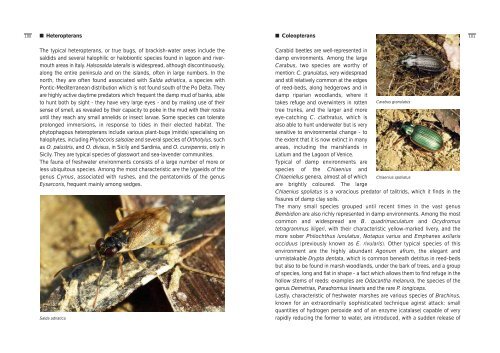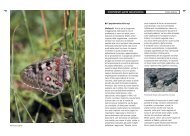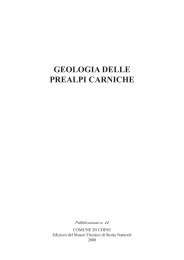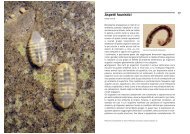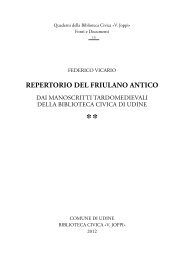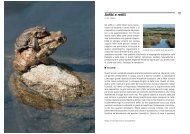Terrestrial invertebrates - Udine Cultura
Terrestrial invertebrates - Udine Cultura
Terrestrial invertebrates - Udine Cultura
You also want an ePaper? Increase the reach of your titles
YUMPU automatically turns print PDFs into web optimized ePapers that Google loves.
100<br />
■ Heteropterans<br />
The typical heteropterans, or true bugs, of brackish-water areas include the<br />
saldids and several halophilic or halobiontic species found in lagoon and rivermouth<br />
areas in Italy. Halsosalda lateralis is widespread, although discontinuously,<br />
along the entire peninsula and on the islands, often in large numbers. In the<br />
north, they are often found associated with Salda adriatica, a species with<br />
Pontic-Mediterranean distribution which is not found south of the Po Delta. They<br />
are highly active daytime predators which frequent the damp mud of banks, able<br />
to hunt both by sight - they have very large eyes - and by making use of their<br />
sense of smell, as revealed by their capacity to poke in the mud with their rostra<br />
until they reach any small annelids or insect larvae. Some species can tolerate<br />
prolonged immersions, in response to tides in their elected habitat. The<br />
phytophagous heteropterans include various plant-bugs (mirids) specialising on<br />
halophytes, including Phytocoris salsolae and several species of Orthotylus, such<br />
as O. palustris, and O. divisus, in Sicily and Sardinia, and O. curvipennis, only in<br />
Sicily. They are typical species of glasswort and sea-lavender communities.<br />
The fauna of freshwater environments consists of a large number of more or<br />
less ubiquitous species. Among the most characteristic are the lygaeids of the<br />
genus Cymus, associated with rushes, and the pentatomids of the genus<br />
Eysarcoris, frequent mainly among sedges.<br />
Salda adriatica<br />
■ Coleopterans<br />
Carabid beetles are well-represented in<br />
damp environments. Among the large<br />
Carabus, two species are worthy of<br />
mention: C. granulatus, very widespread<br />
and still relatively common at the edges<br />
of reed-beds, along hedgerows and in<br />
damp riparian woodlands, where it<br />
takes refuge and overwinters in rotten<br />
tree trunks, and the larger and more<br />
eye-catching C. clathratus, which is<br />
also able to hunt underwater but is very<br />
sensitive to environmental change - to<br />
the extent that it is now extinct in many<br />
areas, including the marshlands in<br />
Latium and the Lagoon of Venice.<br />
Typical of damp environments are<br />
Carabus granulatus<br />
species of the Chlaenius and<br />
Chlaeniellus genera, almost all of which Chlaenius spoliatus<br />
are brightly coloured. The large<br />
Chlaenius spoliatus is a voracious predator of talitrids, which it finds in the<br />
fissures of damp clay soils.<br />
The many small species grouped until recent times in the vast genus<br />
Bembidion are also richly represented in damp environments. Among the most<br />
common and widespread are B. quadrimaculatum and Ocydromus<br />
tetragrammus illigeri, with their characteristic yellow-marked livery, and the<br />
more sober Philochthus lunulatus, Notapus varius and Emphanes axillaris<br />
occiduus (previously known as E. rivularis). Other typical species of this<br />
environment are the highly abundant Agonum afrum, the elegant and<br />
unmistakable Drypta dentata, which is common beneath detritus in reed-beds<br />
but also to be found in marsh woodlands, under the bark of trees, and a group<br />
of species, long and flat in shape - a fact which allows them to find refuge in the<br />
hollow stems of reeds: examples are Odacantha melanura, the species of the<br />
genus Demetrias, Paradromius linearis and the rare P. longiceps.<br />
Lastly, characteristic of freshwater marshes are various species of Brachinus,<br />
known for an extraordinarily sophisticated technique aginst attack: small<br />
quantities of hydrogen peroxide and of an enzyme (catalase) capable of very<br />
rapidly reducing the former to water, are introduced, with a sudden release of<br />
101


